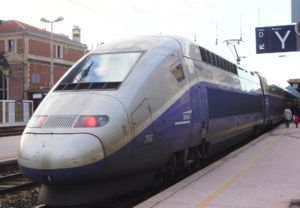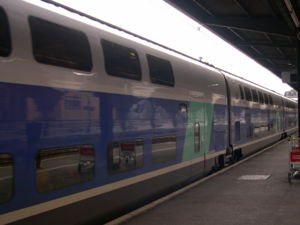SNCF TGV Duplex
- This article was originally based on material from TGVweb, which is licensed under the GFDL.

The TGV Duplex is a French high-speed train of the TGV family, operated by SNCF, the French national railway company. It is unique among TGV trains in that it features bi-level carriages. The Duplex inaugurated the third generation of TGV trainsets, and was specially designed to increase capacity on high-speed lines with saturated traffic. With two seating levels and a seating capacity of 545 passengers, the Duplex maximizes the number of passengers carried in one trainset. While the TGV Duplex started as a small component of the TGV fleet, it has become one of the system's main workhorses.
Why the Duplex?
When a high-speed line reaches its saturation limit, there are several options available to increase capacity. Perhaps the most obvious way is to reduce train headways (the time between each train), i.e. to fit more trains onto the line at once. To achieve this, increasingly complex signalling systems and high-performance brakes (to reduce braking distance) are required. While these avenues have already been pursued to some extent (headways have been reduced to three minutes on some TGV lines), the technical difficulties of continually improving signalling and braking make other solutions to the problem more attractive.
The LGV Sud-Est from Paris to Lyon is the busiest high-speed line in France (perhaps in the world), and since its opening in 1981 it has rapidly reached capacity. The mitigation of this problem was to run pairs of trainsets in multiple-unit (MU) configuration, but even this has not provided enough capacity, and has the added disadvantage of requiring very long station platforms. If you can't make a train longer or wider, then the only way is to make it higher; hence the TGV Duplex, with passenger seating on two levels, and 45% more passenger capacity than an equivalent single-level TGV.
Development history
The Duplex feasibility study was completed in 1987. In 1988, a full-scale mockup was built to gauge customer reactions to the bi-level concept, traditionally associated with commuter and regional rail rather than with high-speed intercity trains. A TGV Sud-Est trailer was tested in revenue service with the inside furnished to simulate the lower floor of a bi-level arrangement, and later that year another TGV Sud-Est was modified to study the dynamic behavior of a train with a higher center of gravity. Discussions with GEC-Alsthom began soon after, and in July 1990 the company won the contract to build the "TGV-2N", as it was then known. The details of the contract were not put in place until early 1991, at which point the official order was made. Since then, technological hurdles have been overcome in a four-year process that led to the first tests of a bi-level trainset in November 1994. Soon after their first run, the first rake of eight trailers was tested at 290 km/h (180 mph) on the Sud-Est line. The trainset was powered by TGV Réseau power cars at the time, as the Duplex power cars were still undergoing development. The first Duplex power car was mated to the bi-level trailers on 21 June 1995.
Innovations
Perhaps the most important innovation is the efficiency of the Duplex design. A comparison between an original TGV Sud-Est trainset and a Duplex trainset speaks for itself:
| Power-to-weight ratio (kW/tonne} |
Weight/seat (tonne) |
Power/seat (kW) | |
|---|---|---|---|
| TGV Sud-Est | 17 | 1.10 | 18.34 |
| TGV Duplex | 23 | 0.7 | 16.15 |
In this comparison, "power" refers to installed power, not all of which is used when operating.
- Aluminium bodies - the strict requirement of a 17-ton axle load limit made it imperative to cut down on weight, wherever possible. Extruded aluminum construction (such as used on the German ICE train) made possible a 20 % reduction in the weight of the structure.
- Improved styling and aerodynamics - the nose of the power units and the gap between trailers were improved such that a Duplex train at cruise speed of 300 km/h (186 mph) experiences only 4 % more drag than a single-level TGV. The nose, the first significant departure from Cooper's original design, was styled by industrial designer Roger Tallon, as was the rest of the trainset.
- Crashworthiness - crush zones and rigid passenger compartments ensure maximum safety in the event of a collision. The power units' frame is designed to take a (steady-state) 500 metric tonnes of force frontal load, and features structural fuses to absorb impact energy.
- Active pantograph - the Faiveley CX used on the Duplex has a pneumatically actuated active control system. Two small gas cylinders in the wiper armature can tune the stiffness of the pantograph's upper stage, to optimize contact at any speed.
- All wheel disc brakes - earlier TGVs (including Eurostar) used disc brakes only on unpowered axles. Weight gains on the Duplex power units allowed the installation of disc brakes directly on the wheels of powered axles (so-called "cheek discs"), instead of using the traditional tread brakes. This does not greatly improve braking performance, but it leaves the wheel tread smooth and considerably reduces rolling noise.
- Quiet roof fans - the cooling fans in TGV power units produce the most noticeable sound (a loud hum) when the train is in a station. The fans, located in the roof of the unit, have been redesigned to be quieter.
Technical data
Build Dates: 1995-1997
Territory: LGV Sud-Est
Top Speed: 300 km/h (186 mph)
Supply Voltages: 25 kV 50 Hz AC, 1.5 kV DC
Traction: 8 3-phase synchronous AC traction motors, 8800 kW (12000 hp) under 25 kV supply.
Length and Weight: 200 m / 380 tonnes
Configuration: 1 power car + 8 trailers + 1 power car, 545 seats
Performance Metrics: 23 kW/tonne / 0.70 tonnes/seat / 16.15 kW/seat
Spotting Features: Bi-level seating, single windshield, rounder nose
Special Notes: Developed to relieve congestion on LGV Sud-Est.
| Multiple units of SNCF | |
|---|---|
| Diesel and gas-turbine multiple units | |
| Diesel units: | X 2100 - X 2200 - X 2400 - X 2700 - X 2720 - X 2770 - X 2800 - X 3600 - X 3700 - X 3800 - X 4200 - X 4300 - X 4500 - X 4630 - X 4750 - X 4790 - X 4900 - X 5500 - X 5800 - X 9100 - X 72500 - X 73500 - X 73900 - X 76500 - X 94750 - X 97150 |
| Trailers: | XR 6000 - XR 6200 - XR 7300 - XR 7800 |
| Turbotrains: | T 1000 - T 2000 - TGV 001 |
| Electric multiple units | |
| DC: | Z 1200 - Z 1300 - Z 1400 - Z 1500 - Z 3600 - Z 3700 - Z 3800 - Z 4100 - Z 4200 - Z 4400 - Z 4500 - Z 4900 - Z 5100 - Z 5300 - Z 5600 - Z 7100 - Z 7300 - Z 7500 |
| AC: | Z 6000 - Z 6100 - Z 6300 - Z 6400 - Z 11500 |
| Dual-voltage: | Z 8100 - Z 8800 - Z 9500 - Z 9600 - Z 20500 - Z 20900 - Z 21500 - Z 22500 - Z 23500 - Z 24500 - U 25500 - Z 26500 - Z 27500 - Z 92050 |
| Bi-mode units: | B 81500 - B 82500 |
| TGV: | Eurostar - TGV Atlantique - TGV Duplex - TGV La Poste - TGV POS - TGV Réseau - TGV Sud-Est - Thalys PBA - Thalys PBKA |

